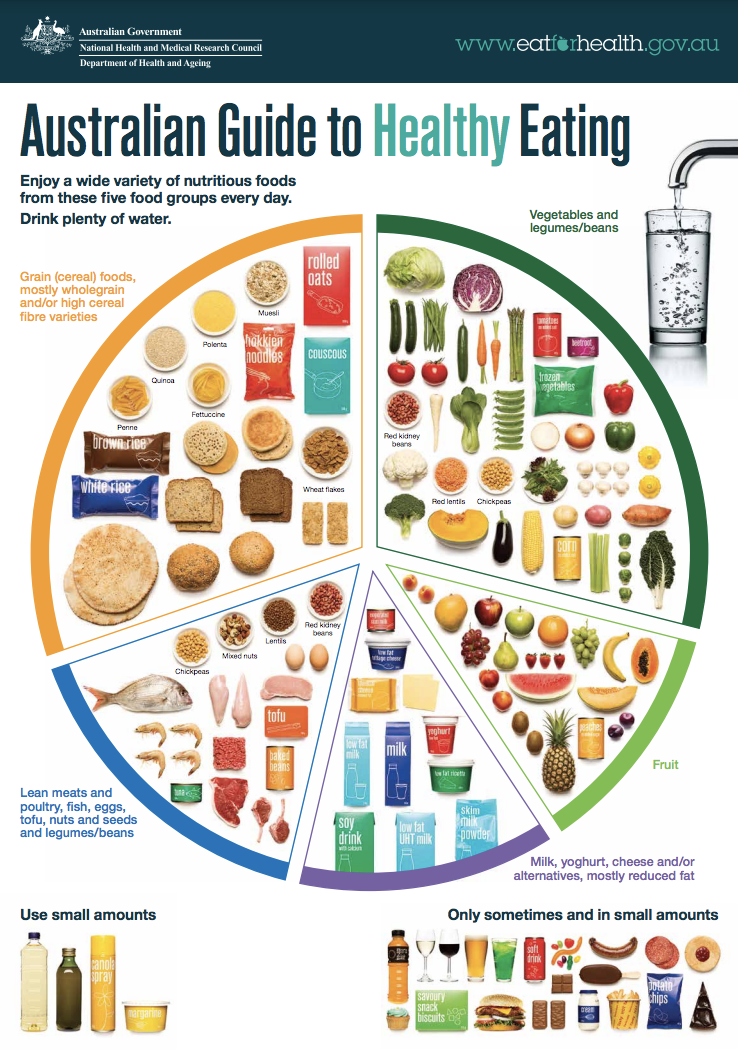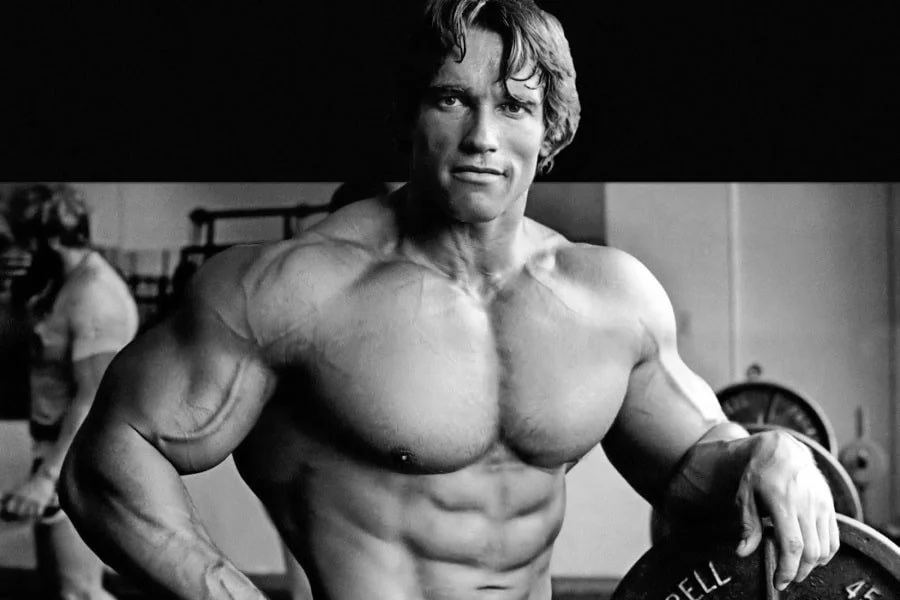
NUTRITION EDUCATION
Lesson 1: A simple overview to healthy eating for the general population.
It’s important to understand that you need a wide variety of food to allow your body to function to its best ability. Peanut butter on toast every second meal isn’t quite going to cut it… Not saying peanut butter is bad, just that you’re missing out on so many vitamins and minerals from a wider variety of food. The “Australian guideline to healthy eating” chart is a good visual representation to what we should be eating. Here are the key take aways:
A vide variety of foods (Lean protein choices, dairy/alternatives, fruit, vegetables/legumes/beans and finally grains (wholegrain preferred).
The amount of each of these categories you should consume daily.
What you should consume in smaller amounts (Sugars, alcohol, high saturated fat snacks, processed foods (e.g. ham)).
Remember this is just a guide for the general population. Not for individuals who seek to be better than ordinary. But, for most of us it’s a really good visual reminder of what to eat.
Lesson 2: Understanding energy & what allows us to feel a million bucks…
What’s energy come from? It’s pretty simple. It’s the food you eat. However energy is not created equal. Depending on what you eat, will dictate the amount of energy is available and how quickly it can be used.
The three main sources of energy come from your macronutrients (energy nutrients) : carbohydrates, proteins and fats. Macro = Large. Think about your macronutrients are you big rocks in your nutrition. In everything you eat, it has a combination of the macronutrients. Later on we will review each of these individually, but for now it’s important to recognise that they are different in regards to what they provide us with and the function within the body. Now, let’d talk about micronutrients.
Micronutrients (vitamins and minerals) are one of the major groups of nutrients your body needs to function, without our body suffers to perform properly (1). Vitamins are necessary for energy production, immune function, blood clotting and other functions. Meanwhile, minerals play an important role in growth, bone health, fluid balance and several other processes (1). Without a wide variety of fruits, vegetables, grains, proteins and dairy, your body won’t receive the needed micronutrient needed to function to the best of it’s ability. Ultimately, that’s how you’re going to feel a million bucks. If you’re struggle to get something from your diet, there are other options in regards to supplementation (which we will chat about later). Now let’s review the most immediate source of energy!
Lesson 3: Carb’s for energy!
Typically calorie dense, carbohydrates are used to fuel our body when we need energy. When we think of energy, typically people think of fruit or even sugar. Both are examples of simple carbohydrates. Which brings me to my next point; there’s two types of carbohydrates. Simple and complex. So what’s the core difference? Simple carbs release energy significantly quicker rate into the bloodstream (2). These “fast acting” carbs, provide the body with energy much faster than complex carbs. Complex carbs have a significantly slower release into the bloodstream (2). What are some examples?
Simple Carbohydrates:
Refined sugar (lollies, gatorade etc)
Fruit (bananas, oranges etc).
White bread / pastas.
Complex Carbohydrates:
Starchy vegetables (Sweet potato)
Whole grains (wholegrain pasta, bread etc)
Fibre rich fruits (apples, berries etc)
You may ask “so when should i have one or the other?” Great question.
Take this example: You’re playing a match of AFL. Your team is winning by 7 points against a team thats undefeated. You play in the midfield and you feel spent as you’ve had only a few minutes of rest each quarter… You’re depleted of energy. Are you going to have a sweet potato (complex carbs) to give you that immediate energy that you crave? Absolutely not. It’s absurd. You body won’t be able to break it down quick enough to use it for energy. Instead you’ll quickly drink a gatorade. Gatorade has roughly 40g of sugar that your body will be able to absorb and use as energy. As we know (from the hydration section), that gatorade has multiple benefits outside of being a simple carbohydrate. Hopefully now that gives you some context around when to have simple and complex carbs. Remember, theres no such thing as “bad” carbs. It depends on how you use them.
Lesson 4: Consequences of a lack of protein…
10 week transformation photo of our client Arnie… Just kidding. Not sure how he would move out on a football oval.
Consequences of a lack of protein?
Basically, protein is needed for the growth and formation of new tissue, and it also helps to repair any muscle fibres that may have been damaged through exercise (3). Without protein, our body can start to lose muscle mass, which causes our function to decrease. So what does this mean for performance? Here’s some examples of how it impacts performance:
Decreased power output. Think 5-10m acceleration.
Decreased Top Speed. 100m sprint down the wing when chasing an opponent.
Decreased Reaction time. Not being able to respond quickly.
Slower recovery rate from exercise.
These are just a few of many consequences. Hopefully now you can see the importance in every meal. So how often should we have protein? Our bodies can absorb close to 30g of protein per hour (4). From that 400g steak for dinner, you’re probably only getting 1/4 of it’s protein content. To ensure we get enough protein, increasing your meal frequency at which you consume a balance meal can be helpful. So instead of one big meal with protein, try and break down your protein consumption into more frequent meals. So, coach. How much protein do i need to have? For the athletic population, you need to consume 1.5-1.8g per kilogram of body weight.
For example:
A 80kg athlete.
1.5g x 80kg = 120 , 1.8g x 80kg = 144.
The 80kg athlete will need 120-144 grams of protein each day.
Now let’s briefly touch on the difference between animal and plant based proteins. There’s lot of differences which i could write a considerable amount on. To keep it simple here’s the main difference. Generally, animal proteins are known as complete proteins, meaning they contain all nine essential amino acids. While some plant proteins, including pea protein and soybeans, are also complete protein sources, many other plant foods are considered incomplete proteins. For instance, the amino acid Leucine is found in higher concentrations in animal products vs plant based products. If you don’t get enough of this amino acid, your body will regenerate / recovery from exercise at a slower rate. Also it’s worth noting that plant based products aren’t as dense in protein, therefore you have to eat a lot more to get the required amount of protein. So what do i do if i can’t get enough protein? Speak to our nutritionist about your options / creating a plan of attack for you.
Lesson 5: Should i supplement?
This should be a real quick lesson. Humans tend to want a real easy quick fix in life. “Drink this formula and lose 10kg in 3 months”. Unfortunately companies use not accurate advertisement and marketing strategies to get people to buy there products. Don’t get caught up in this trap, as i have when i was much younger, and much less wiser. Supplements should be used if you cannot get the macro or micronutrient from your diet. So if you’re not getting enough protein in your diet, try eating more protein first. If this is difficult, then a protein powder is a good option. Before supplementing, i’d encourage you to send an email to our nutritionist.
Task & Discussion:
Now you should have a basic understanding of sports nutrition. Now let’s put your understanding to practice. Complete the following!
Task 1 - Create a “Everyday - Nutrition Plan”
Once you’ve completed the Task, implement change to your diet for 2 weeks. After 2 weeks, complete the Nutrition Review again to see your improvement!
Need some extra help?
ADDITIONAL NUTRITION SERVICES
Our nutritionist is here to help:
Meal plans & calculating macronutrient demands.
Building a healthy relationship with food - working out energy demands and how much you should be eating.
Sports nutrition & holistic guidance to performance.
** please note this is at an additional cost**
Click the link below to book in for your 1v1 consultation.




